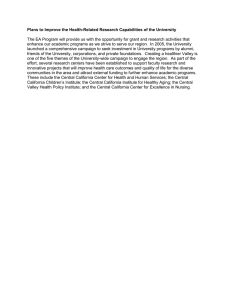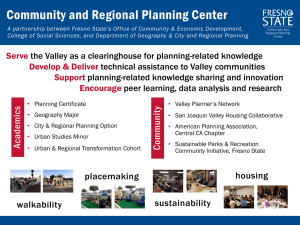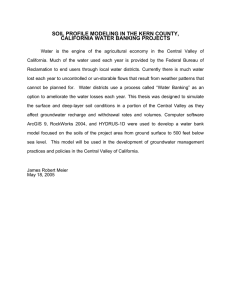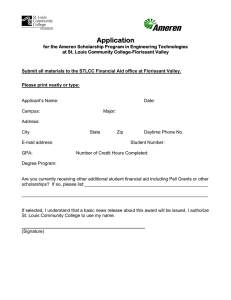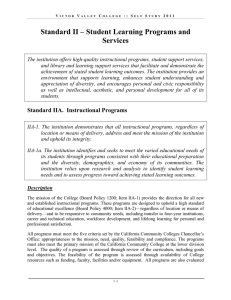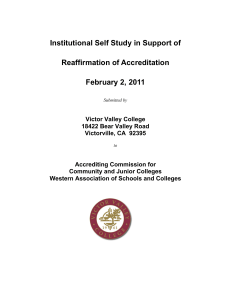Introduction to Victor Valley College
advertisement
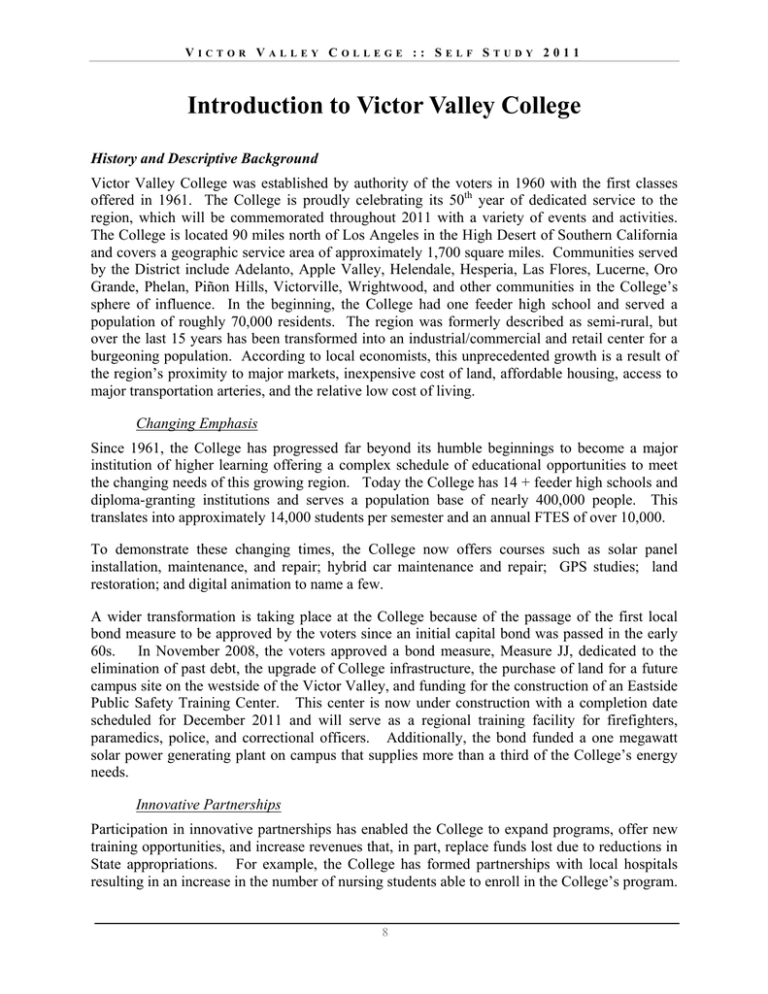
V ICTOR V ALLEY C OLLEGE :: S ELF S TUDY 2011 Introduction to Victor Valley College History and Descriptive Background Victor Valley College was established by authority of the voters in 1960 with the first classes offered in 1961. The College is proudly celebrating its 50th year of dedicated service to the region, which will be commemorated throughout 2011 with a variety of events and activities. The College is located 90 miles north of Los Angeles in the High Desert of Southern California and covers a geographic service area of approximately 1,700 square miles. Communities served by the District include Adelanto, Apple Valley, Helendale, Hesperia, Las Flores, Lucerne, Oro Grande, Phelan, Piñon Hills, Victorville, Wrightwood, and other communities in the College’s sphere of influence. In the beginning, the College had one feeder high school and served a population of roughly 70,000 residents. The region was formerly described as semi-rural, but over the last 15 years has been transformed into an industrial/commercial and retail center for a burgeoning population. According to local economists, this unprecedented growth is a result of the region’s proximity to major markets, inexpensive cost of land, affordable housing, access to major transportation arteries, and the relative low cost of living. Changing Emphasis Since 1961, the College has progressed far beyond its humble beginnings to become a major institution of higher learning offering a complex schedule of educational opportunities to meet the changing needs of this growing region. Today the College has 14 + feeder high schools and diploma-granting institutions and serves a population base of nearly 400,000 people. This translates into approximately 14,000 students per semester and an annual FTES of over 10,000. To demonstrate these changing times, the College now offers courses such as solar panel installation, maintenance, and repair; hybrid car maintenance and repair; GPS studies; land restoration; and digital animation to name a few. A wider transformation is taking place at the College because of the passage of the first local bond measure to be approved by the voters since an initial capital bond was passed in the early 60s. In November 2008, the voters approved a bond measure, Measure JJ, dedicated to the elimination of past debt, the upgrade of College infrastructure, the purchase of land for a future campus site on the westside of the Victor Valley, and funding for the construction of an Eastside Public Safety Training Center. This center is now under construction with a completion date scheduled for December 2011 and will serve as a regional training facility for firefighters, paramedics, police, and correctional officers. Additionally, the bond funded a one megawatt solar power generating plant on campus that supplies more than a third of the College’s energy needs. Innovative Partnerships Participation in innovative partnerships has enabled the College to expand programs, offer new training opportunities, and increase revenues that, in part, replace funds lost due to reductions in State appropriations. For example, the College has formed partnerships with local hospitals resulting in an increase in the number of nursing students able to enroll in the College’s program. 8 V ICTOR V ALLEY College :: S ELF S TUDY 2011 Internships with one of the local cities have created additional training opportunities for automotive students, and grants received through State and County agencies have expanded workforce development programs that eventuate in immediate employment opportunities for students. The College has also increased outside sources of revenue through lease agreements with local and regional entities. A History of Success For 50 years, thousands of residents from the High Desert and beyond have journeyed to the College and have gone on to achieve remarkable success. From their ranks are civic leaders, business people, service industry personnel, medical providers, first responders, and people of all walks of life who are contributors to the health and welfare of our community. In 2006, the College Foundation commissioned a study with UCLA Anderson School of Management to determine the economic impact the College has on our local economy. This report estimated the annual gross impact to be nearly $900 million. Community, Organizational, and Student Profiles Community Demographics The College’s service area encompasses 1,700 square miles in the High Desert of Southern California. Our borders are shared with Barstow, Copper Mountain, San Bernardino, Chaffey, and Antelope Valley community college districts. 9 V ICTOR V ALLEY C OLLEGE :: S ELF S TUDY 2011 Figuree 1. Service Arrea In 2000, the populatiion in the serrvice area was w 279,625. Over the lasst nine yearss, it has increeased by 28.7% % to 392,37 71. As reveaaled in Tablle 1, the inccorporated areas a within the servicee area (Adelantto, Apple Vaalley, Hesperria, Victorvillle) account for 82.7% of o the populaation. 10 V ICTOR V College :: S ALLEY ELF S TUDY 2011 Table 1. Service Area by Zip Code 2000 Population Service Area 91759 92284 92285 92301 92307 92308 92342 92344 92345 92356 92358 92368 92371 92372 92392 92394 92395 92397 Mt Baldy Yucca Valley Landers Adelanto Apple Valley Apple Valley Helendale Hesperia Hesperia Lucerne Valley Lytle Creek Oro Grande Phelan Pinon Hills Victorville Victorville Victorville Wrightwood 484 20,866 2,125 18,972 30,580 29,528 4,846 7,714 60,807 5,309 753 972 12,449 3,996 30,758 13,560 31,406 4,500 Difference (2000‐09) 2009 Population 545 24,561 2,425 32,232 36,832 38,984 6,050 18,342 74,184 6,417 855 1,093 15,591 4,703 52,452 32,162 39,446 5,497 11.2% 15.0% 12.4% 41.1% 17.0% 24.3% 19.9% 57.9% 18.0% 17.3% 11.9% 11.1% 20.2% 15.0% 41.4% 57.8% 20.4% 18.1% 279,625 392,371 28.7% Source: Rural Opportunities Environmental Scan – counts may be slightly higher than city reports due to the use of zip codes All of the incorporated areas show substantial increases since 2005. For example, Victorville’s population increased 30.3% between 2005 and 2009 (see table below). Table 2. Population by Incorporated Areas Adelanto Apple Valley Hesperia Victorville 2000 2005 2006 2007 2008 2009 18,972 60,108 68,521 75,724 23,418 63,853 76,114 86,473 NA 75,075 90,534 100,672 25,718 69,835 90,312 97,534 28,049 68,305 94,798 118,748 32,232 75,816 92,526 124,060 Difference (2005‐09) 27.3% 15.8% 17.7% 30.3% All counts are estimates Source: 2000 = Rural Opportunities Environmental Scan – counts may be slightly higher than city reports due to the use Source: 2005 = S.B. County Demographic Profile Source: 2006‐2008 = American Community Survey (US Census Bureau) Source: 2009 = Rural Opportunities Environmental Scan – counts may be slightly higher than city reports due to the use From 2000 to 2009, the median household income increased 23.8% (39,289 vs. 48,644) in our service area. This was beneficial to the area’s households because the price of housing also increased at an alarming rate over this same time frame. However, due to the recession, housing 11 V ICTOR V ALLEY C OLLEGE :: S ELF S TUDY 2011 values have decreased substantially resulting in much of the population owing more on their homes than they are worth. In addition, due to the poor economy, the unemployment rate has increased from 9.3% in 2000 to 16.2% in 2009. These factors have contributed to increased annual enrollment numbers for 2009-2010 of almost 20,000 credit students. Educational Needs of Service Area As depicted in Table 3, the percentage of people who graduated from high school has increased slightly in the last nine years (29.5% vs. 31.5%). In addition, the proportion of people who obtained a college degree has increased 15.5% during this same time period. Table 3. Educational Attainment by Service Area 2000 Population < 9th Grade Some High School HS Grad Some College Associate's Degree Bachelor's Degree Graduate Degree or Higher 2009 Population 10,686 26,779 50,120 49,313 13,024 12,637 7,120 6.3% 15.8% 29.5% 29.1% 7.7% 7.4% 4.2% 16,248 33,138 77,352 64,061 20,625 22,538 11,568 6.6% 13.5% 31.5% 26.1% 8.4% 9.2% 4.7% 169,679 100.0% 245,530 100.0% Although more people are finishing high school, placement into college-level courses continues to be low for the population. As shown below, very few students place in transfer-level reading, mathematics and English writing courses. Table 4. Accuplacer Placement Rates for Fall 2008 Mathematics English Writing Reading 1.1% 3.9% 95.0% 13.8% 47.3% 38.9% 45.8% 22.4% 31.8% Transfer Level 1 Level below transfer 2 or more levels below transfer Educational Delivery to Service Area The College has grown exponentially and with that comes the challenge of servicing a more diverse and eclectic population. The College continues to underrepresent males in the service area, yet Hispanics (37.2%), Blacks (14.5%), Asians (3.2%), and Pacific Islanders (0.5%) are overrepresented (see table below). Table 5. Gender (VVC Students vs. Service Area) Male Female 2000 Population 2009 Population 49.4% 50.6% 49.8% 50.2% 12 VVC (Fall '09) 42.0% 58.0% V ICTOR V ALLEY College :: S ELF S TUDY 2011 Table 6. Race/Ethnicity (VVC Students vs. Service Area) 2000 Population 2009 Population VVC (Fall '09) 67.5% 6.2% 1.1% 1.8% 0.2% 23.2% 59.0% 6.6% 1.1% 2.3% 0.2% 30.8% 43.8% 14.5% 0.8% 3.2% 0.5% 37.2% 100.0% 100.0% 100.0% White Black American Indian Asian Pacific Hispanic It is noteworhthy that the College’s proportion of 35 to 44 year olds closely resembles that of the service area. This may be due to the poor economy and that many people have lost their jobs requiring them to look to the College for re-training and skill improvement. The increase in fulltime students (34.9% in 2009) could also be an indicator that students are feeling the need to complete their education more quickly in order to enter the workforce. Table 7. Age (VVC Students vs. Service Area) 2000 Population <20 20‐24 25‐29 30‐34 35‐44 45‐59 >59 2009 Population VVC (Fall '09) 96,111 14,634 14,381 16,981 44,013 47,219 46,286 34.4% 5.2% 5.1% 6.1% 15.7% 16.9% 16.6% 120,309 26,532 26,682 22,645 49,601 79,045 67,557 30.7% 6.8% 6.8% 5.8% 12.6% 20.1% 17.2% 4,564 3,731 1,692 1,088 1,516 1,084 138 33.0% 27.0% 12.2% 7.9% 11.0% 7.8% 1.0% 279,625 100.0% 392,371 100.0% 13,813 100.0% Occupational Outlook in Service Area (2009) Top 10 most often occurring industries in service area (highest to lowest): 1. Full-Service Restaurants 2. Offices of Real Estate Agents and Brokers 3. Religious Organizations 4. Commercial and Institutional Building Construction 5. Beauty Salons 6. Insurance Agencies and Brokerage 7. Elementary and Secondary Schools 8. Offices of Physicians (except Mental Health Specialists) 9. General Automotive Repair 10. Plumbing, Heating, and Air-Conditioning Contractors Top industries by number of employees in service area (highest to lowest): 1. Home Centers 2. Offices of Physicians (except Mental Health Specialists) 13 V 3. 4. 5. 6. 7. 8. 9. 10. ICTOR V ALLEY C OLLEGE :: S ELF S TUDY 2011 All Other Traveler Accommodation Legislative Bodies Supermarkets and other Grocery (except Convenience) Stores Offices of Real Estate Agents and Brokers Department Stores (except Discount Department Stores) General Medical and Surgical Hospitals Full-Service Restaurants Elementary and Secondary Schools Top 10 industries by number of sales in service area (highest to lowest): 1. Other Miscellaneous Durable Goods Merchant Wholesalers 2. Offices of Real Estate Agents and Brokers 3. Home Centers 4. Department Stores (except Discount Department Stores) 5. Commercial and Institutional Building Construction 6. Used Car Dealers 7. General Medical and Surgical Hospitals 8. Supermarkets and other Grocery (except Convenience) Stores 9. New Car Dealers 10. Petroleum and Petroleum Products Merchant Wholesalers (except Bulk Stations and Terminals) Meeting the Job Demand In addition to its well-established career-technical programs, the College’s latest program developments have focused on future prospects in green industry sectors. Through outside funding sources the College now offers training for the following: solar technicians, hybrid mechanics, aviation mechanics, and waste water technicians. A new program in health information technologies has also been added to the College’s already strong training programs for health industry jobs. Table 9. Job Demand and Earnings (Newest Programs) SOC Code Description 2009 Jobs 2015 Jobs Annual Openings 49-3011 Aircraft mechanics and service technicians Aircraft structure, surfaces, rigging, and systems assemblers Avionics technicians 73 81 3 Current Hourly Earnings $27.99 <10 <10 -- -- <10 <10 -- -- 118 130 5 $29.29 112 124 5 $17.81 73 90 4 $25.58 51-2011 49-2091 13-1031 29-2071 51-8031 Claims adjusters, examiners, and investigators Medical records and health information technicians Water and liquid waste treatment plant and system operators 14 Education Level Postsecondary vocational award Long-term on-thejob training Postsecondary vocational award Long-term on-thejob training Associate's degree Long-term on-thejob training V ICTOR V ALLEY College :: S ELF S TUDY 2011 Table 10. Job Demand – Regional, State, National SOC Code 49-3011 51-2011 49-2091 13-1031 29-2071 51-8031 Description Aircraft mechanics and service technicians Aircraft structure, surfaces, rigging, and systems assemblers Avionics technicians Claims adjusters, examiners, and investigators Medical records and health information technicians Water and liquid waste treatment plant and system operators Regional ChangeVol 8 1 Regional % Change State % Change National % Change 11% 45% 3% -6% 4% 3% 1 15% -1% 6% 12 10% 1% 3% 12 11% 12% 12% 17 23% 13% 12% Student Learning and Achievement The College’s use of established procedures resulted in the identification of student learning outcomes (SLOs) for 100% of courses and its general education program. Evaluation of courses and programs is achieved through curriculum review processes and integration of SLOs and other student achievement data into its annual program review, planning, and resource allocation processes. The centrality of faculty in maintaining quality and ensuring course and program improvement is authorized by Board policy, guided through formally established administrative procedures, and demonstrated throughout the long history of active involvement by faculty in program review and planning. Institutional Program Review and Planning The College’s Educational Master Plan guides overall institutional planning and development. Other critical planning documents include annual program review and budget planning (Program Review, Allocations, and Institutional Strategies for Excellence or P.R.A.I.S.E.) reports, Matriculation, Student Equity, Disaster Preparedness, Technology, and Facilities Plans. The College’s planning process is broad-based and offers opportunities for participation across the institution. Progress on Learning Outcomes Assessment The College has made significant progress on developing an institutional framework for learning outcomes assessment. As of Fall 2010, student learning outcomes have been written for 100% of active credit courses and certificate programs. In addition, general education student learning outcomes have been approved by the Academic Senate for the Associate of Arts and Associate of Science degrees. Student learning outcomes have also been drafted for the Student Services Division, and for the Matriculation, Disabled Students Programs and Services (DSPS), Extended Opportunity Programs and Services (EOPS), Cooperative Agencies Resources for Education (CARE), and CalWORKS programs. Student learning outcomes are included in each syllabus distributed every term to students in each course section. The College’s Academic Senate has adopted a course-embedded approach to the assessment of student learning outcomes. Accordingly, methods of assessment are identical with the methods 15 V ICTOR V ALLEY C OLLEGE :: S ELF S TUDY 2011 of evaluation that are required components of each course and program outline of record and are reviewed by the Curriculum Committee prior to the approval of each curriculum proposal. Student learning outcomes for the Associate degrees are assessed within courses that meet one or more of the categories within the general education program. In addition, methods of assessment have been identified for several student services programs, including Matriculation, DSPS, and EOPS/CARE. Learning outcomes assessment reports are integral parts of the program review templates adopted by the Academic Senate for instructional and student support programs, and a comprehensive report of learning outcomes assessment for courses is included in the Annual Report of Institutional Effectiveness. A full cycle of learning outcomes assessment was completed during the 2007-2008 academic year by several faculty teams who received financial support from a Title V, Hispanic Serving Institutions (HSI) grant. One faculty trainer with experience in assessment received additional grant funds to offer training across disciplines during the 2008-2009 year. The first comprehensive assessment report, based on data gathered at the end of 2009, showed that assessments were being conducted in 11% of credit courses. Moreover, 19% of instructional program reviews submitted in 2010 reported assessment results with 8% reporting the use of assessment results for instructional improvement. Beginning in March 2008, a faculty member was awarded 20% reassigned time as a Student Learning Outcomes and Assessment Facilitator in order to assist faculty and administration with learning outcomes development and assessment. Off-Campus Sites and Distance Learning The College’s off-site locations and distance education program have significantly expanded student access to courses in all areas of general education and in many career technical fields. Courses are offered at many locations across the service area given that high desert residents (approximately 350,000 of them) are spread throughout the College’s service area of 2200 square miles. Locations have included the following: APPLE VALLEY COUNTRY CLUB SO CAL LOGISTICS AIRPORT APPLE VALLEY HIGH SCHOOL SPRING VALLEY LAKE COUNTRY CLUB EXCELSIOR EDUCATION CENTER STERLING INN HESPERIA COUNTRY CLUB ST JOAN OF ARC CATHOLIC CHURCH HESPERIA HIGH SCHOOL SULTANA HIGH SCHOOL HIGH DESERT CHEER GYM VALLEY CREST RESIDENTIAL HIGH DESERT VILLAS VICTOR VALLEY HIGH SCHOOL HOOK COMMUNITY CENTER VICTOR VALLEY CHRISTIAN SCHOOL LUCERNE VALLEY GUN RANGE VVC EDUCATION CENTER LUCERNE VALLEY HIGH SCHOOL VICTORVILLE PUBLIC WORKS MOUNTAIN VIEW MONTESSORI SCHOOL VICTOR VALLEY WASTE WATER 16 V ICTOR V ALLEY College :: S OUR R LADY OF THE T DESERT CHURCH C ELF S TUDY 2011 DISTRICT T TREATMEN NT PLANT PINO ON MESA MIIDDLE SCHOO OL RIM M OF THE WO ORLD HIGH SC CHOOL SILV VERADO HIG GH SCHOOL The num mber of coursse offerings at off-campuus sites havee increased in i recent yeaars in responnse to populatioon changes in the regioon: 19 sectiions in Fall 2005 to 622 sections inn Fall 2009.. The College’ss particular emphasis on o serving the eastern--most and western-mos w st regions of the service area a has beeen supportedd by the succcessful bonnd measure in i 2009 that will enablle the constructtion of 2 offf-site facilitties shown on the figurre below, onne focused on public safety s training (eastern ( regiion) and the other on workforce deveelopment in general (western region). Figgure 2. Location n of Future VV VCCD Centers Online classes makee up an averaage of 22% of the total sections off ffered each term t and havve an f rate that exceeds the District ratee for credit classes. c Blackboard© iss the most widely w average fill used deliivery system m for the Colllege’s distannce educatioon program. The Collegge’s Service Desk provides technical Blackboard suupport in peerson, by phoone, and throough email for both studdents 17 V ICTOR V ALLEY C OLLEGE :: S ELF S TUDY 2011 and instructors, and a student self-assessment tool is available for students to measure their readiness to succeed in a distance education class. In addition to online classes, the College offers hybrid and web-enhanced sections that blend face-to-face and electronic instructional methods. All courses in which a portion of instruction is provided by distance education receive separate review by the curriculum committee and are required to meet the same standards of quality as conventionally delivered courses. The Distance Learning Facilitator is appointed from the faculty and receives .20 reassigned time in order to assist in maintaining and improving technical support and educational effectiveness in the College’s distance education program. Audit of Federal Grant Monies An external audit of compliance in accordance with standards generally accepted in the United States of America is conducted annually. Specifically, this audit includes examining on a test basis evidence about College compliance with government auditing standards and Office of Management and Budget Circular A-133. External auditors must determine whether the College complies with such specified requirements. The latest audit for the period ending June 30, 2010, was recently completed and there were no findings. College Organizational Chart See figure on next page. 18 V ICTOR V ALLEY College :: S ELF Figure 3. Organizational Chart 19 S TUDY 2011


